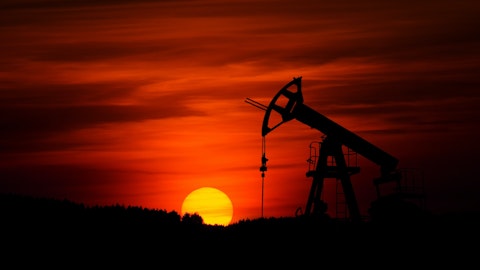If you go back to – I think, it was back in 2019, the first kind of full year we had Mariner East online, we had very high utilizations in the U.S. Gulf Coast and the arms were wide, they were $0.15, $0.20 to $0.25 a gallon. And you saw us capture that. And so that’s ultimately something that we could see play out this year. Sorry for 2024, where you could have weaker Mont-Bellevue pricing like you’ve seen here in the third quarter, but strong arms in Antero. As we move into 2024, we do capture some of that value. Today, we have some contracts that are term deals that roll off before the end of the first quarter. And so beyond that, in 2024, we’re fully uncontracted and able to capture that value. And so I think you’ll see that reflected in our NGL realizations if that plays out like it’s looking right now on the propane side.
I think the other tailwind is just on the freight costs, you’ve seen freight costs stay elevated this year. We hit record levels a month or so ago and that’s been driven by some delays getting through the Panama Canal, the well publicized low water levels that they have down there. And so that’s again something temporary. And if you look at the futures curves for LPG freight costs, they’re backwardated U.S. to Asia is about $0.12 per gallon lower by midsummer of 2024 versus now, and that’s a pretty steady decline in those expected costs. So that’ll also allow prices in the U.S. to rise as well as that freight cost declines. On the oil, nothing I think that we can provide specific to that. Obviously, there’s a lot of moving parts with geopolitical risks and OPEC.
I do think we’re seeing, particularly on the GL side of supply responses, we’ve seen the rig count decline. You saw some very steep increases in U.S. propane inventories back in the spring, even though exports were strong. And as we moved through the back half of the year with similar levels on exports, you’ve seen those propane increases wane and we’ve come back into the five year range. So I think that to me, points to what we talked about with the ring counts where things are responding on the supply side here domestically as well. And we’ll have to see if that plays out on the oil side in 2024.
Umang Choudhary: Very helpful. Thank you so much for all the color. I guess the next question, which I had is I just wanted to follow-up on the operational momentum, which has been really strong here recently. Would love your initial thoughts on 2024 production and capital spending outlook and also if you can touch a little bit on deflation and what you’re expecting there too, which can probably add some upside to the 10% reduction number, which you were talking about from a capital spending perspective.
Michael Kennedy: Yes. We’re not baking in any deflation. My comments earlier were just addressing the operational efficiencies, capital program efficiencies and well performance that we’ve experienced this year. And assuming those type of efficiencies and performance will allow us to kind of dial in which capital we want, depending on whether we want to keep today’s production flat or what we communicated earlier, the kind of the annual average from last time of 3.35 to 3.4. So that’s what we’re in the process of doing this quarter. So we’ll go through our typical process and then come out with those. Generally, we come out with the budget with the February release, with the year-end release. So we’ll just work through that and continue to watch the market. But we’re not assuming any deflationary aspects in that capital budget. That would just be upside.
Umang Choudhary: That’s really helpful. Thank you.
Paul Rady: Thank you.
Operator: The next question is from Arun Jayaram of JPMorgan. Please proceed with your question.
Arun Jayaram: Yes. Mike, I wanted to get your thoughts on, so you said 10% lower CapEx next year, and that would be to keep the current production outlook, what you’re doing today relatively flat? And then if you drill down to 3.35 to 3.4, it would be more than 10%. Just wondering if you can clarify those comments.
Michael Kennedy: That’s correct. Yes.
Arun Jayaram: Okay. Got it. Got it. And then just I know it’s hard to estimate land spend because you’re opportunistic on that front. But if you’re recommending kind of a placeholder for land spend in 2024, any just broad thoughts on that?



